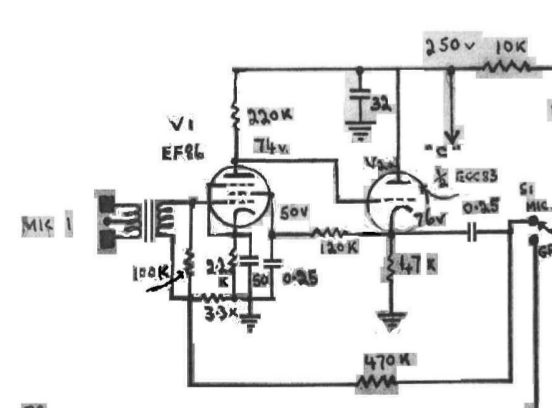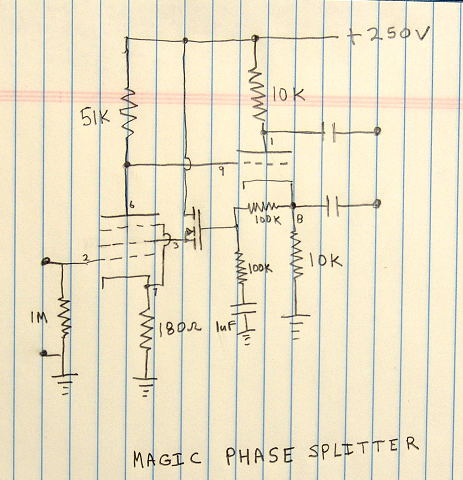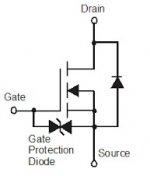The phonostage is then connected to a 6 way rotary input selector switch, from there it connected to the volume control a 100K log potentiometer and tape output.
It been working for over a year with no problems.
It been working for over a year with no problems.
5mA is not enough to pop those zeners.
I agree. Now that the OP posted the source of his circuit, we know the plate load is 270K ohm, so there is no chance there will be a HT spike even 2mA happening through the gate of the MOSFET.
So where else can this spike come from? I already suggested a possibility. Mosfet failure from drain-source is not terribly uncommon.
Ian
The MOSFET cannot damage the clamping zeners.
Put a wire in place of the MOSFET (and unhook the gate) and see what happens to those zeners during turn-on.
🙂
This particular MOSFET has no internal Source-Drain protection. I started to place a diode from source to drain (1n4007) on it some years ago.
Why did I do this? Because one failed on me despite the Gate being protected by a zener - Source to Drain shorted. A zener can work here too, but 1n4007 is perhaps less costly.
Ian
Attachments
Last edited:
That MOSFET gets slammed on at power up, and it clobbers the diodes. What is the value of the drain resistor on the MOSFET? That limits the current the diodes would see.
That could account for it, although I would have expected the OP to have mentioned if he had to replace the MOSFET to get it up and running again.Mosfet failure from drain-source is not terribly uncommon.
That MOSFET gets slammed on at power up, and it clobbers the diodes. What is the value of the drain resistor on the MOSFET? That limits the current the diodes would see.
From post #19 it is 100k ohm.
In addition to the mosfet protection zener and diode, I am now using a Constant Current sink instead of a resistor. It is something I decided to do after reading some things that Allen Wright (RIP) once wrote.
Also, there are other reasons. I would argue that the CC sink would also protect those clamping zeners. However, I do not use clamping zeners and also agree that a smaller value coupling capacitor would probably be fine too.
Now. Which way does current flow? * 🙂
Current is really the movement of electrons. Electrons move from negative to positive. The 100k ohm resistor looks pretty big, so during turn-on the big B+ spike causes the 2,2uF capacitor to become very positive on the circuit side if the MOSFET is source-to-drain shorted. Think about this for a while...
Now, imagine there is a Constant Current sink there instead of the resistor. The electrons will flow through the easiest path, which is through the Constant Current sink. At turn-on, the top of the Constant Current sink will be equivalent to ground during the turn-on spike. It should freely allow at least half a milliamp through while keeping the voltage at null. It will do this much faster than a 100k ohm resistor.
The Constant Current sink "drains" the impact of the turn-on spike much more effectively in this example.
Ian
*Conventionally speaking, we look at current flowing from plus to minus. This is known as conventional current flow. But for solid state devices it is VERY useful to consider the flow of electrons (which is minus to plus). Here is a useful reference article if you are not convinced:
Which Way Does Current Really Flow? | Nuts & Volts Magazine
Last edited:
This is why I use TVS diodes instead. They don't blow up on so easy. Something like this? https://www.mouser.ca/ProductDetail/Littelfuse/SA12CA-B?qs=zHiv0nsVGmrUFP/TX0p41A==
Last edited:
I would not use in audio path something with leakage resistance and capacitance , both variable with voltage and temperature 😀
If you sit and think for a better design you can avoid the need for such "protections"
If you sit and think for a better design you can avoid the need for such "protections"
Just a follow up to the problem.
I've found what caused the clamping diodes to fail in my riaa peramp.
It turns out to be an earthing fault with a valve amp that I borrowed, there is about 20V ac between the chassis and equipment earth.
After speaking to my friend he mentioned when touching the case he could feel a small tingle, he now ask me to take a look at it and sort it out for him.
I've found what caused the clamping diodes to fail in my riaa peramp.
It turns out to be an earthing fault with a valve amp that I borrowed, there is about 20V ac between the chassis and equipment earth.
After speaking to my friend he mentioned when touching the case he could feel a small tingle, he now ask me to take a look at it and sort it out for him.
Last edited:
Thanks for updating, most people don't bother! That makes a lot more sense than the explanations people were throwing around in this thread 🙄It turns out to be an earthing fault with a valve amp that I borrowed, there is about 20V ac between the chassis and equipment earth.
*rubs nails on lapels*😎the surge came from outside, feeding into the output.
May I suggest you a variation on this schematic?
Instead of having a fixed g2, use it for feedback à la Rupert Neve (with a source follower instead of cathode follower):

Gain stage with g2-feedback.
Or like George suggested here if you need a differential output:

"magic" phase splitter for SimpleP-P
Instead of having a fixed g2, use it for feedback à la Rupert Neve (with a source follower instead of cathode follower):
Gain stage with g2-feedback.
Or like George suggested here if you need a differential output:
"magic" phase splitter for SimpleP-P
x2 caps
if you have any equipment feeding off the same power strip that has this x2 caps and you are not using the grounding terminals, or the earthing is not connected, surely you will get this tingling sensations...
so earthing is really important to be safe.....
Just a follow up to the problem.
I've found what caused the clamping diodes to fail in my riaa peramp.
It turns out to be an earthing fault with a valve amp that I borrowed, there is about 20V ac between the chassis and equipment earth.
After speaking to my friend he mentioned when touching the case he could feel a small tingle, he now ask me to take a look at it and sort it out for him.
if you have any equipment feeding off the same power strip that has this x2 caps and you are not using the grounding terminals, or the earthing is not connected, surely you will get this tingling sensations...
so earthing is really important to be safe.....
Last edited:
- Home
- Amplifiers
- Tubes / Valves
- EF86 with mosfet follower clamping diodes short circuit?
